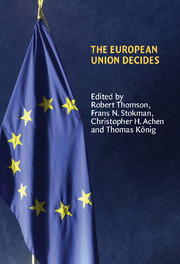Book contents
- Frontmatter
- Contents
- List of figures
- List of tables
- Notes on contributors
- Preface
- 1 Explaining legislative decision-making in the European Union
- 2 Research design: measuring actors' positions, saliences and capabilities
- 3 Testing procedural models of EU legislative decision-making
- 4 Institutional realism and bargaining models
- 5 Compromise, exchange and challenge in the European Union
- 6 Nash versus Schelling? The importance of constraints in legislative bargaining
- 7 A cooperative approach to decision-making in the European Union
- 8 A procedural exchange model of EU legislative politics
- 9 Beyond informal compromise: testing conditional formal procedures of EU decision-making
- 10 Evaluating political decision-making models
- 11 Evidence with insight: what models contribute to EU research
- Appendix I Selection of Commission proposals
- Appendix II Comparison of expert judgements with each other and with information from Council documentation
- References
- Index
- Title in this series
Appendix II - Comparison of expert judgements with each other and with information from Council documentation
Published online by Cambridge University Press: 22 September 2009
- Frontmatter
- Contents
- List of figures
- List of tables
- Notes on contributors
- Preface
- 1 Explaining legislative decision-making in the European Union
- 2 Research design: measuring actors' positions, saliences and capabilities
- 3 Testing procedural models of EU legislative decision-making
- 4 Institutional realism and bargaining models
- 5 Compromise, exchange and challenge in the European Union
- 6 Nash versus Schelling? The importance of constraints in legislative bargaining
- 7 A cooperative approach to decision-making in the European Union
- 8 A procedural exchange model of EU legislative politics
- 9 Beyond informal compromise: testing conditional formal procedures of EU decision-making
- 10 Evaluating political decision-making models
- 11 Evidence with insight: what models contribute to EU research
- Appendix I Selection of Commission proposals
- Appendix II Comparison of expert judgements with each other and with information from Council documentation
- References
- Index
- Title in this series
Summary
Obtaining information from policy area experts was essential in this research project given that decision-making in the European Union, and particularly in the Council, is often a secretive and specialised affair. Documentation on Council decision-making on politically sensitive dossiers has, until very recently, not been available. Many experts we interviewed spoke of an unwritten rule, according to which information on other member states' positions in the Council should not be divulged. Still, many were willing to provide this information, given the scientific nature of our inquiry, and under the condition that they would be thanked not by name, but by institutional affiliation. We obtained Council documents on the discussions on some of the Commission proposals included in our selection, and these provided fascinating information that supplements, rather than substitutes the information provided by experts. Policy discussions in the Council, particularly at working group level, are often of a technical nature. This makes it difficult and often impossible to distinguish between peripheral technical matters and political issues that form the most important elements of the debate. Consultations with experts are essential to making such distinctions, and to drawing our attention to the links between apparently separate points that are in fact parts of the same issue. Furthermore, content analysis of documentation does not offer acceptable operationalisations of some of the concepts contained in our models: for instance, the level of importance actors attach to the issues being discussed.
- Type
- Chapter
- Information
- The European Union Decides , pp. 329 - 347Publisher: Cambridge University PressPrint publication year: 2006
- 10
- Cited by

